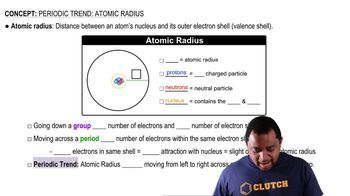Here are the essential concepts you must grasp in order to answer the question correctly.
Atomic Radius
The atomic radius is a measure of the size of an atom, typically defined as the distance from the nucleus to the outermost electron shell. In the context of solid metals, the atomic radius can influence the packing arrangement of atoms in a crystal lattice, which is crucial for determining the type of crystal structure.
Recommended video:
Crystal Structures
Crystal structures refer to the orderly arrangement of atoms in a crystalline solid. The two common types are primitive cubic (where atoms are located only at the corners of the cube) and face-centered cubic (where atoms are at the corners and the centers of each face). The arrangement affects properties like density and atomic packing efficiency.
Recommended video:
Density and Packing Efficiency
Density is defined as mass per unit volume and is influenced by the arrangement of atoms in a crystal structure. In face-centered cubic structures, atoms are more closely packed than in primitive cubic structures, leading to higher density. Calculating density from atomic radius can help determine the type of crystal structure present in a material.
Recommended video:
 Verified step by step guidance
Verified step by step guidance


